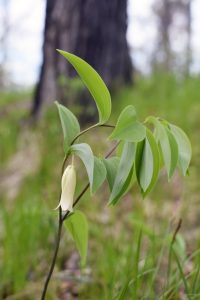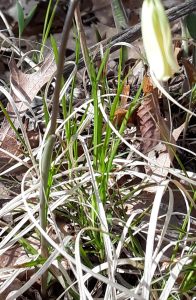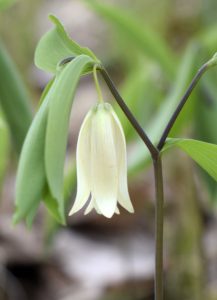Sessile-leaf Bellwort
 Uvularia sessiliflolia is a shade-loving perennial found in deciduous and mixed deciduous evergreen forests. Look for the dainty bell-shaped flower peeking out from beneath the leaves, about an inch long, with 6 slender petals hanging downward and slightly flared out at the bottom. Blooming just a bit later than Hepatica, and in similar habitat, this lovely plant’s single stem rises 4″ to 12″ from the forest floor April into June. The stem is green at first, but by the time the plant flowers, the upper portion of the stem turns reddish purple. The lower portion of the stem at the base is sheathed (see photo).
Uvularia sessiliflolia is a shade-loving perennial found in deciduous and mixed deciduous evergreen forests. Look for the dainty bell-shaped flower peeking out from beneath the leaves, about an inch long, with 6 slender petals hanging downward and slightly flared out at the bottom. Blooming just a bit later than Hepatica, and in similar habitat, this lovely plant’s single stem rises 4″ to 12″ from the forest floor April into June. The stem is green at first, but by the time the plant flowers, the upper portion of the stem turns reddish purple. The lower portion of the stem at the base is sheathed (see photo).

 Flowers emerge singly (rarely, they can occur in pairs), drooping downward beneath leaf branches on slender stalks emerging from the axil (the angle where leaf meets stem). Meanwhile, in the forest canopy above, new leaves of oaks and maples are unfolding, allowing nourishing light to penetrate to the many springtime plants nearby that are sending up their first leaves — arrivals such as Solomon’s seal, wood anemone, Canada mayflower, and red columbine. Look closely among these first green leaves near the forest duff, and you may well find some bellwort flowers fully formed and quietly presenting their cream colored petals for your contemplation.
Flowers emerge singly (rarely, they can occur in pairs), drooping downward beneath leaf branches on slender stalks emerging from the axil (the angle where leaf meets stem). Meanwhile, in the forest canopy above, new leaves of oaks and maples are unfolding, allowing nourishing light to penetrate to the many springtime plants nearby that are sending up their first leaves — arrivals such as Solomon’s seal, wood anemone, Canada mayflower, and red columbine. Look closely among these first green leaves near the forest duff, and you may well find some bellwort flowers fully formed and quietly presenting their cream colored petals for your contemplation.
Sessile-leaf bellwort is so named due to the fact that the leaves are sessile, meaning they have no petioles (stalks) and instead are attached directly to the stem of the plant, though not clasping it. Leaves are alternatively attached, generally smooth edged, have parallel veins, and are somewhat rolled when the flower is blooming. With maturity the leaves flatten out as the flower later forms into fruit. The main stem forks into two branches towards the top, forming a zig zag pattern between the leaves. Roots colonize by sending out horizontal runners along the ground (called ‘stolons’), and can act as a ground cover this way as the plant expands its area. Along with the stolons, plants propagate by seeding out each year.
Sessile-leaf bellwort grows from Little Bass Lake’s Beaver Pond trail entrance onward along the road and up the hill – and anywhere in Minnesota that offers moist, partly shady woodlands and thickets with rich humus. Also known as ‘straw lily’ or ‘wild oats’.
